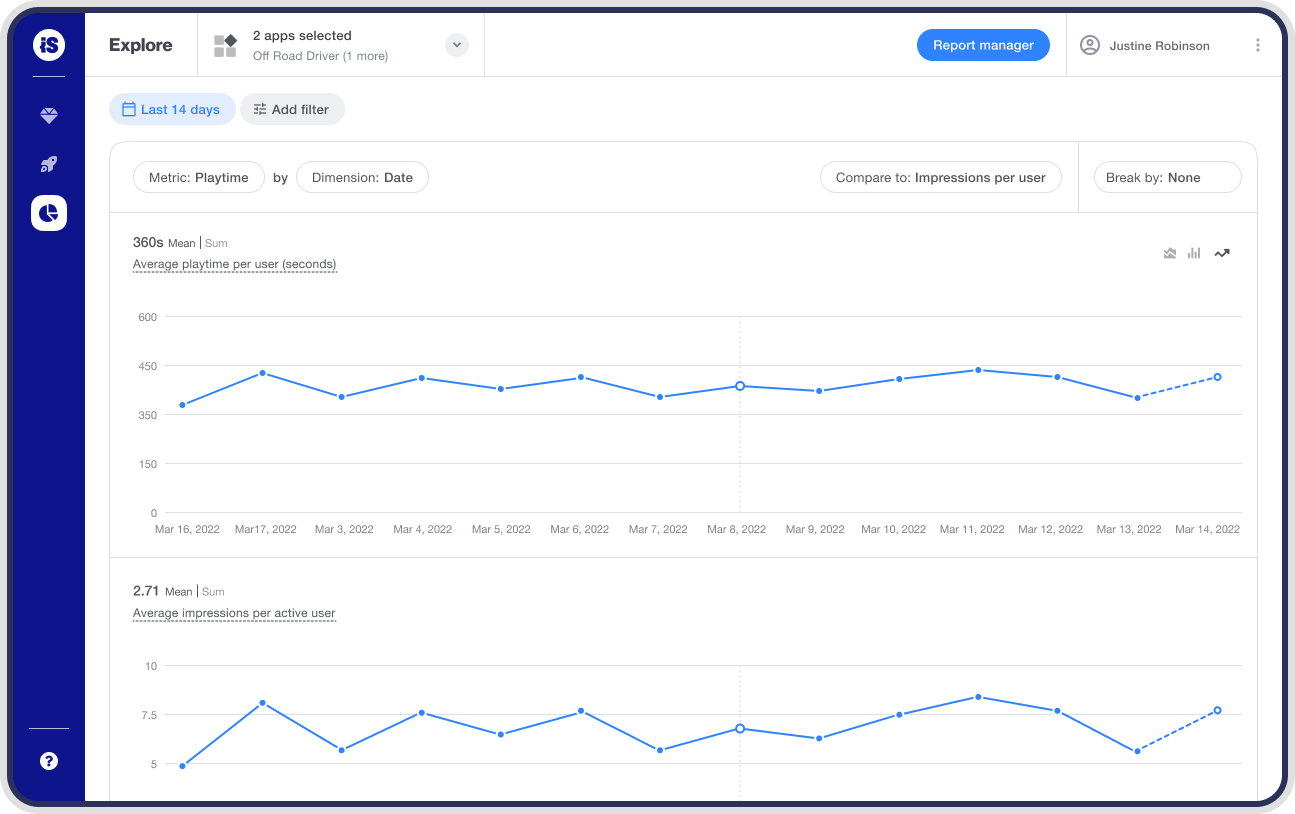Optimizing monetization and UA is key for growth - but they only get you so far if the app itself isn't optimized. In fact, the best way to maximize growth is by tying monetization and user acquisition data to user behavior. The more granular you can get, the more you can do to strengthen your business.
Using ironSource's App Analytics solution to break down the data, here are 3 ways you can better optimize for growth.
#1: Reconciling impressions vs playtime
There’s typically a tradeoff between the number of impressions you serve users versus its effect on user engagement (playtime). That’s because game designers are determined to improve the user experience in the game, while monetization managers are focused on maximizing the revenue per user. The key to reconciling these pain points is to deep dive into each metric to find the sweet spot that maximizes both.
For example, you can compare playtime versus impressions per user, side by side. Let’s say you want to increase impressions from a cap of 3 to 5. The first step is to assess whether this affects playtime, and make the best adjustments to ensure a positive user experience. If you see a significant drop in playtime, it’s a sign that users weren’t happy, and a lesson to return to the original impressions cap. However, if increasing the cap has no effect on playtime - you can generate revenue without affecting user experience.
Now your data-informed conclusions can improve both user experience and profits. It’s not always easy to find the optimal point between them, but looking at them side by side with a tool like App Analytics can help to reconcile multiple interests.

#2: Improving user engagement with cohorts
Traditionally, retention analysis focuses on user churn. Going one step further - not just looking at if users return, but also understanding their behavior when they return - paints a much clearer picture about how to better retain users and find more places to monetize them.
Assessing how users play
To encourage your players to keep going, first understand what’s already motivating them in the first place. If you have in-app purchase API data, simply split paying versus non-paying users and see how they compare in different metrics (playtime, impressions per user, sessions, session length, etc.). Now you can better understand your paying users and how they differ from non-paying users - for example, if you see that session length is higher for paying or non-paying users, you can use this information to your advantage.
Let’s say App Analytics shows there was a spike in your revenue on a cohorted day. You also see that your users were running out of the initial resources from their starter pack and hadn’t utilized ways to earn more, like clans and special events. Your profits spiked because users only had one choice - to keep playing, they had to use in-app purchases to gain more resources.

Offering just the right reward amount
To determine a reward amount that continuously engages users, you need to first understand your users. Start by looking at impressions per user. The figure should be fairly consistent, especially if you’re capping impressions, but it’s still important to monitor this number for any technical issues.
Let’s say you see a drop in impressions on day 5 on the App Analytics platform. You can dive deeper to understand why - it turns out that on day 5, users received a special daily bonus with a lot of gems. However, they acquired so much currency, they didn’t need to watch a rewarded video to move forward - which is why impressions were low that day.
The best practice would be to decrease the reward on day 5, so that users stay in the sweet spot: engaged in the game but needing extra gems to progress.
Maximizing your strengths
To increase your user retention, you want to maximize exposure to events that engage users, like clans. To do that, look for areas in the game with increased playtime and determine whether it’s connected to an event. For example, if you see increased playtime on day 8 and know that users usually unlock the clan on day 8, you can infer that’s why you saw a spike. Great! Let’s put our focus here.
Try moving the clan date earlier in the user experience. If you can identify key engagement moments in the game and offer those experiences before the typical drop in retention, you have a better chance at retaining users for a longer period. You can track the success of this decision on the App Analytics cohorts page by using both the retention and playtime metric for users who were exposed to this change.
#3: Determine your milestones with the funnel page
To boost user playtime and revenue, we need to optimize how users move from one milestone in the game to another. This is where funnels come in: with a custom events API on App Analytics, you can create custom funnels and immediately see how users progress through your milestones, or fall in the pitfalls between them. For example, you can create a level funnel that shows how many users started level 1, then progressed to level 2, and so on.
Optimizing your in-app purchase flow
To best understand your user journey in action, define exactly what you’re interested in observing and create clear funnels based on that path. For example, if you’re looking to convert more users into paying users, you might want to understand user purchase patterns. You can create funnels that filter users who make a specific purchase, and follow whether users continue making purchases after that. Informed by your new funnels, you can start using trial and error to adjust your in-app purchases’ rewards or placements and increase your conversion rate.
Optimizing engagement (level drop)
The majority of users drop off in the first days of playing. So to improve user engagement, it’s essential to monitor the onboarding process. Using funnels, define each of your onboarding milestones and order them chronologically - for example, “registration,” “privacy policy,” “select avatar,” and more. This way, you can view the dropoff rate between them.
These insights can inform exactly the tweaks your game needs to improve retention. We recommend you test your changes with A/B testing. In fact, you can dive even deeper. If you created a “select avatar” milestone, you can focus on specific avatars to gain more insight. If the conversion rate is much higher for players who chose a specific avatar, you can use this information to update your game accordingly.

You can also assess behavior by level. For example, if suddenly on level 3 there’s a major drop in conversion rate, it’s an indication to dig deeper and understand the cause. Create a level funnel to understand how conversion changes incrementally. Try to find the origin - did this drop happen before level 3, or during it? All of this information will bring you closer to making the adjustments needed to improve engagement, boosting game performance.
With any app, understanding user engagement is the key to understanding how to scale up your business. App Analytics ensures this process is easy and intuitive by providing different pages (explore, cohorts, and funnels) to zoom in on user behavior and understand what’s affecting it. Learn more about App Analytics here.




